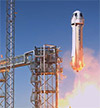Critical Site Selection Factor #5: Available Buildings
People expect near-instant delivery on just about everything these days, and companies seeking new facilities are more likely than ever to want to pick a location and have it up and running as quickly as possible.
Q4 2016
The need for available buildings fits logically into the world of just-in-time delivery, and because companies are operating in an environment of constant change and adjustment, they’re more likely to want a compressed project timeframe — not a long, drawn-out process. “It can be a driver, especially if you’re in a hurry,” says Richard H. Thompson, international director, Supply Chain and Logistics Solutions for Jones Lang LaSalle. Developers are stepping up in their creation of speculative space. Research from Jones Lang LaSalle finds a national increase in the completion of speculative warehouse projects. The problem is that space is being absorbed nearly as quickly as it is being added to the market. Also, the firm reports, “Increased momentum in the preleasing of speculative space prior to completion continues to tighten vacancy rates.”
Given that, “this is becoming more important as a criterion,” says Thompson. “I would not have said that last year, but industrial vacancy rates are at an all-time low.” At many points in recent years, “you’ve typically been able to find something that will work for you,” Thompson says. These days, though, “availability is at an all-time low.”
I would not have said that last year, but industrial vacancy rates are at an all-time low. Richard H. Thompson, international director, Supply Chain and Logistics Solutions, Jones Lang LaSalle For example, he says, vacancy rates for distribution center space are averaging under 8 percent on a national basis. That’s an already low number, but “in some of the hotter markets, the vacancy rates are down to 2 percent, which is very low, like unheard-of low.” He cites eastern Pennsylvania as an example where it can be a challenge to locate available buildings for certain specific uses, along with such places as Chicago and the Inland Empire region of California.
Available or New?
As is the case with many location considerations, the importance of this factor “is highly dependent on the nature of the project,” says Christopher D. Lloyd, senior vice president, Infrastructure and Economic Development, at McGuireWoods Consulting LLC. In quite a few cases, the hunt for just the right available building in exactly the right place will ultimately lead nowhere. According to Lloyd, companies will often come into the process in a big hurry, and tell him, “We’d like you to find an existing facility, so we can get in and open quickly.” And then, after spelling out the details of what they’re seeking, they end up building rather than buying or leasing.
That’s not to say the right building is never out there, and for some uses, it’s not as difficult to find. “The availability of buildings can be important for certain office uses and certain distribution uses, certain low-end manufacturing or wet labs,” Lloyd says, and for them, there might be a fit. But in many more cases, the right building in the right place just isn’t available. “With a lot of manufacturing processes, or maybe the way a data center is set up, it’s so specialized that you need to build the building around it,” he concludes.
Project Announcements
Process Machinery Expands Shelby County, Kentucky, Production Operations
04/26/2025
HL Mechatronics Expands Williams Township, Michigan, Operations
04/26/2025
Norplas Industries Expands Highland Park, Michigan, Operations
04/26/2025
General Dynamics Ordnance and Tactical Systems Establishes Camden, Arkansas, Operations
04/26/2025
Cyclic Materials Plans Mesa, Arizona, Recycling Operations
04/26/2025
Amazon Plans Marshall County, Mississippi, Inbound Cross Dock Operations
04/26/2025
Most Read
-
Run a Job Task Analysis
Q4 2024
-
The Location Economics of Advanced Nuclear
Q1 2025
-
39th Annual Corporate & 21st Annual Consultants Surveys: What Business Leaders and Consultants Are Saying About Site Selection
Q1 2025
-
NEW NIMBYism: A Threat to The U.S. Economy
Q4 2024
-
Power, Policy, and Site Selection in 2025
Q1 2025
-
Why Workforce Readiness Can’t Wait
Q1 2025
-
Designing Beyond the Assembly Line
Q1 2025



